Professor Gu developed Synthetic Beta-cell transplant for Diabetic Patients
World's 10% of the population gets the Diabetes Mellitus. Around 6 millions of the 30 millions people in the US with Diabetes manages this condition using some insulin treatments either by some regular injections or with infusion pumps.
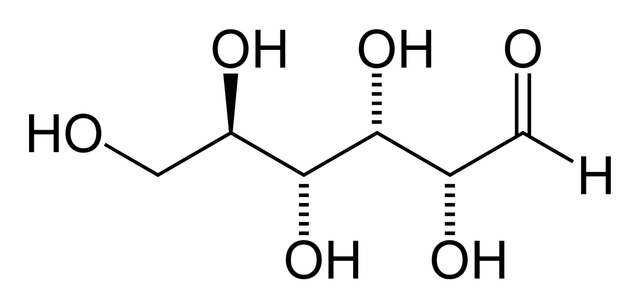
Fig: Glucose molecule (source)
Glucose is a type of sugar which has some trouble in moving from blood to our body cells . That means there is high concentration of glucose in our blood than in the body cells . Glucose has become a source of energy for the cells in the human body. So, when there is less glucose in the cells then the cells starve for energy even after having the glucose in their doorstep (i.e blood).
Generally, our body regulates the amount of glucose in our blood and the amount getting into the body cells by the help of two hormones :
- Insulin
- Glucagon
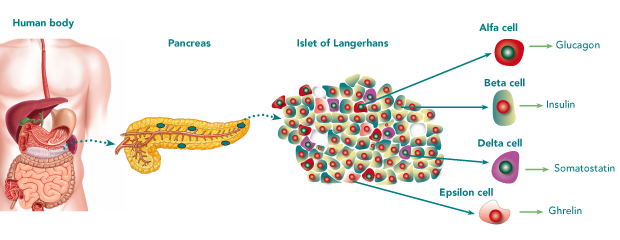
Fig: Hormones produced by different Pancreatic cells (source)
Insulin hormone functions to maintain the blood/glucose level by decreasing it which the Glucagon hormone functions to maintain blood/glucose level by increasing the level.
If you know or not, these cells are mainly produced by the clusters of cells in the pancreas which is called as Islets of Langerhans. Insulin is secreted by the Beta-cells which lies in the center of the Islets of Langerhans while the glucagon is secreted by the Alpha-cells which lies at the periphery of the Islets of Langerhans.
Insulin reduces the blood/glucose level by binding to the insulin receptors lodged in the cell membranes of various insulin responsive tissues like the adipose tissues and the muscle cells.When insulin gets attached, the insulin receptors transfers signals causing the vesicles containing glucose transporter to fuse with the cell membrane. When this happens, the glucose from the blood is transferred to the cell via a glucose transporter attached to the cell membrane from vesicle.
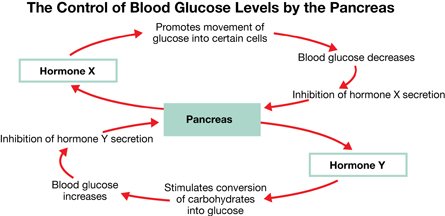
Fig: Hormone cycle of X - Insulin Y- Glucagon (source)
On the other hand, Glucagon has exact the opposite effect. It raises the blood/glucose level by generating a new molecules of glucose from the other molecules from liver and even breaking down the glycogen for making glucose molecules. These all molecules of glucose gets into the blood making high blood/glucose level.
What is Diabetes Mellitus ?
Diabetes Mellitus a condition when the blood/glucose level becomes too high. Due to the underlying mechanism that makes the blood/glucose level rise differentiates the Diabetes Mellitus into two categories :
- Type-1 Diabetes Mellitus
- Type-2 Diabetes Mellitus
Type-1 Diabetes Mellitus
Type -1 Diabetes mellitus sufferers are the world's 10% of the population suffering from Diabetes.In this condition, the body doesn't make enough insulin to maintain blood/glucose level. The reason behind this is that there is the type-4 hypersensitivity reaction going on or a cell-mediated immune response on the pancreas by it's own T-Helper cells. (T-cells fight against all kinds of antigen or foreign bodies that are a small peptides or lipids or polysaccharides which happens to be some part of our own body cells.) These T-cells dont usually harm the normal body cells and this is maintained by some Self-tolerance. During the Type-1 diabetes, there is some kind of genetic abnormality which looses some self-tolerance among these T-cells. These T-cells start attacking the Beta-cells of the pancreas which happens to be the source for Insulin. Self-tolerance of the T-cells passes it's signals to other immune cells and co-ordinate their attack in harming these Beta-cells. Beta-cells destruction means less insulin and ultimately, less insulin refers to glucose dumping in the blood-stream as it doesn't pass the body cells.
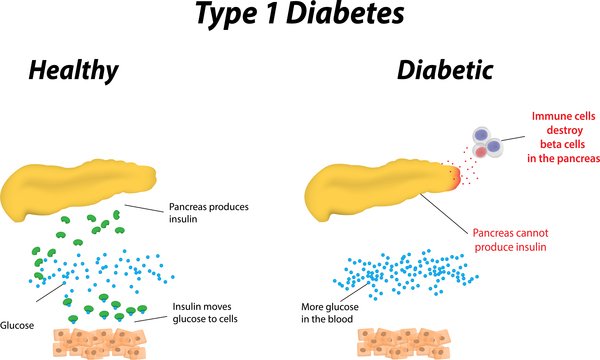
Fig: Difference between healthy and type -1 Diabetes Mellitus (source)
Most important genes called as HLA-gene (Human Leukocyte Antigen) is involved in this process of regulation of the immune response. This is also called as HLA system. This gene has some basically some genes on chromosome six that generally codes for the Major Histocompatibility Comples (MHC). It is made up of protein that recognizes the foreign molecules which helps in maintaining immune system and also maintain self-tolerance.MHC is a key that opens the lock of antigen and present to the immune cells for destruction. Some kind of HLA-DR3 and HLA-DR4 genes happens to be common in most of the Type-1 Diabetes patient. Here, the Beta cells starts to destroy in early life and sometimes about 90% of Beta-cells destroy before the symptoms evoke in them.
Patients with Diabetes Mellitus comes with the symptomes of
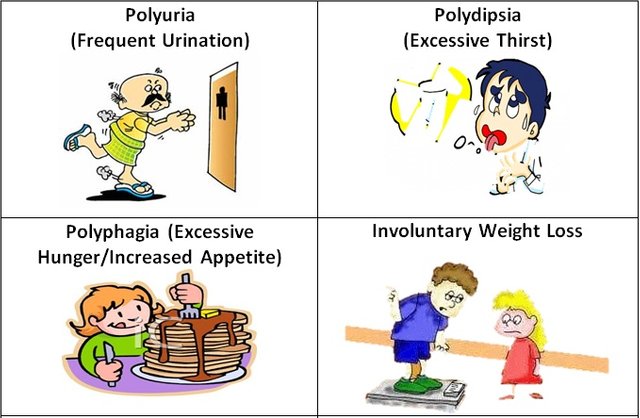
Fig: Symptoms of Diabetes mellitus (source)
Polyphagia
When there is less Insulin, there is high amount of glucose in blood. The cells don't enough glucose which happens to be the source of energy for them . When there is less glucose, the adipose tissue breaks down into fat complex called as lipolysis and the muscles tissues starts breaking down into the proteins. These two causes a massive weight loss in the patient with uncontrolled diabetes. Breaking down phases or a catabolic phage or state makes the patient hungry and eat a lot due to sense of hunger . This is called as Polyphagia. Poly meaning a lot and Phagia means eating.
Glycosuria
Glycos means glucose and Uria means Urine. The high blood/glucose levels blood starts filtering through the kidneys and some parts of glucose gets in the urine. The presence of glucose in urine is called as Glycosuria.
Polyuria
Glucose is the highly osmotic substance. It carries the water in the direction of flow. The water follows the glucose and ultimately increases the urine called as Polyuria. Poly means a lot and Uria means urine.
Polydipsia
When there is uncontrolled urination in the patient of uncontrolled diabetes, there is the problem of dehydration. Patient feels thirsty which is called as Polydipsia. Poly means a lot and dypsia means thirst.
People with diabetes aren't able to produce the insulin at normal levels but they can sense the insulin and respond to insulin. So the treatment can be lifelong insulin therapy for regulating their blood/glucose level and make sure to use the glucose by the cells for the energy purpose.
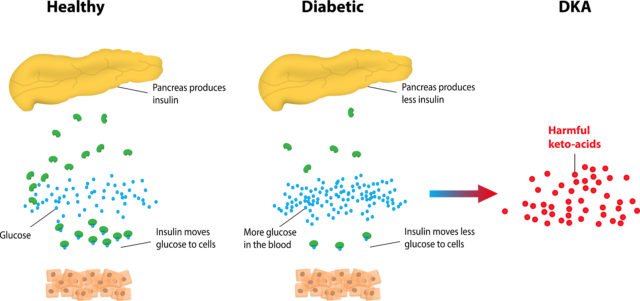
Fig: Generation of Diabetic Ketoacidosis (source)
Lipolysis , process where the adipose tissue is broken down into the free fatty acids and is trasferred to liver.The liver turns this free fatty acids into the ketone bodies like Beta-hydroxybutyric acid and acetoacetic acids. These ketone bodies are used by the cells for energy purpose but these bodies on the other hand increases the acidity of the blood which is so called to be ketoacidosis. And during diabetes, when this occurs, it is referred as Diabetic Ketoacidosis which is a serious complication of the Type-1 Diabetes mellitus. During this condition, i.e when the acidity of blood is raised, the patient develops
- Kussmaul Respiration (laboured and deep breathing to move the carbon-dioxide out of the blood to reduce acidity)
- Human cells have a H+/K+ pump in the membrane and when the acidity of blood is raised, the potassium ions get exchanged with the hydrogen ion leading to trasfer of potassium ion to the fluid from inside the cell. On the other hand, when the Insuline dependent receptors work, there is the working of Na +/K+ pump which brings the potassium inside the cells. But unfortunately, when no insulin is produced, the postassium ion stays awake outside the cell i.e stays in fluid. This two mechanism thus increases the potassium ion more in the fluid system and in blood which is to be known as Hyperkalemia.
- Due to the ketoacidosis, there is high build up unmeasured negative and positive ions in the blood or serum where High anion gap occurs.
Previously diagnosed with the Diabetes mellitus or patient with ongoin therapy for Diabetes can develop the Diabetic Ketoacidosis. The patient when becomes stress or goes into some infection, there is the release of Nor-epinephrine levels which simultaneously increases the Glucagon levels. Due to such massive releases of glucagon hormone, there is hormonal imbalance between the glucagon and insulin which can hamper the blood/glucose levels producing the cascade of above symptoms like Polydipsia, Polyphagia, Polyuria and Glycosuria.
There is some sweetness in this condition. When these two ketone bodies breaks down , it breaks down into acetone.The acetone escapes as a gas through breathing out of the lungs.The smell has some kind of sweet fruity smell when person breaths out. Further, this can lead to vomiting, nausea and if it happens to be severe, the acute cerebral edema occurs and even the mental status changes accordingly. During this DKA (Diabetic Ketoacidosis), the treatment is providing some electrolytes as potassium fluids, Insulin to lower the blood glucose levels and some other fluids to lower the dehydration risks.
Type -2 Diabetes Mellitus
Type-2 Diabetes mellitus is considered as the condition where the insulin levels are normal but the respond to the insulin by the tissue is absent. Some review tells that the glucose transporter that works by the Insulin-dependent receptor has no response. Glucose transporter doesn't move to the cell membrane and neither the response occurs with the insulin which occurs to be insulin resistance. Some of the risk factors that makes the cell to be insulin resistance are Obesity, Lack of exercise and Hypertension.

Fig: Type -2 Diabetes Mellitus (source)
Some studies tells that when the adipose tissue or fat are in excess, there is cause of release of free fatty acids called as adipokines. These are the signaling molecules which can induce inflammation to the cell. Due to this inflammation, there is generation of insulin resistance by the cells .
Genetic role has a huge hand in triggering diabetes since most obese people are not diabetic. Type-2 Diabetes people tissue don't respond towards the insulin when it is in normal level. Due to this, the body produces more insulin to get the normal effect in blood/glucose level. The cells goes hyperplasia which is the Beta-cell of pancreas hyperplasia means increasing the number of Beta cells of pancreas and Beta-cell hypertrophy which is the increased size of the Beta-cell. These all forces to produce more insulin. This mechanism works for some time by increasing the insulin level higher than normal for maintaining the blood/glucose level normal called as normoglycemic condition.
Along with these insulin, the Beta-cells of pancreas also secrets Islet Amyloid Polypeptide or just amylin. During this phases of increased secretion of insulin, there is also an increased secretion of the amylin. Due to excess use of Beta cells, hypertrophy and hyperplasia of this cell, these cells happens to be exhausted and becomes dysfunctional. These Beta cells then goes to hypotrophy and becomes small .These also goes hypoplasia and dies off in the pancreas. Ultimately, when these Beta cells are lost, the insulin levels goes to ground level which do a direct impact on the blood/glucose level. The level rises and patient follows hyperglycemia leading to the above mentioned cascade of symptoms like Polyphagia, Polydipsia, Polyuria and Glycosuria.
From differentiating with Type-2 Diabetes, there is some little amount of insulin circulating in the patients blood which comes from some Beta cells trying to compensate the insulin resistance condition. These Type-1 Diabetic pateint don't usually develop Diabetic Ketoacidosis (DKA).Here, a condition called as Hyperosmolar Hyperglycemic State (HHS) is occured than in the type-2 Diabetes mellitus. There is a severe dehydration and increased concentration of blood due to increased plasma osmolarity.
Glucose acts as a solute because it is a polar molecule and cannot pass through the cell membrane by diffusion. The glucose pulls out the water from the body cells to blood vessels leaving the body cells shrink and dry rather than hydrated and juicy. This leads to the total body dehydration due to increased urination. This can lead to serious complications and situations dur to the dehydrated cells in the body and brain causing mental status changes. During the Hypeosmolar Hyperglycemic State (HHS), we can see ketonemia and some acidosis but not more likely to the Diabetic Ketoacidosis.
There are also various types of Diabetic mellitus, Gestational Diabetes is a kind of diabetes in which a pregnant women during its third trimester has increased blood/glucose level. This is caused by the pregnancy hormones that interferes with the insulin on the insulin receptors. Drug-Induced Diabetes, is a condition where there is increased blood/glucose level due to side effects by various medicines. This both diabetes is most common with the type-2 diabetes which is like a insulin resistance rather than a autoimmune destruction process like type -1 diabetes.
The type of diabetes is diagnosed by the level of glucose floating around the blood pathways.It has a standard values that the World Health Organization uses :
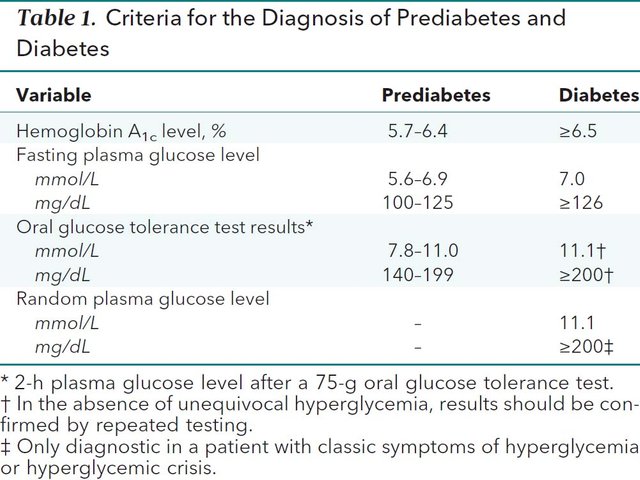
Fig: Standard Values developed by World Health Organization (WHO)
Fasting Glucose levels are taken very commonly.Here, the person doesn't drink or eat execpt water for 8 hours and has his/her blood tested for glucose levels. So, when the levels of glucose in blood is 110-125 mg/dl then it indicated Prediabetes and higher than 126 mg/dl indicates diabetes. Non-random glucose test is a test which can be done at random times where the level of glucose is with 200 mg/dl or more than that indicated the diabetes. Oral Glucose Tolerance test is type of test where a person is provided with glucose and the blood samples are taken at certain time intervals to know the rate of clearance from body. 140-100 mg/dl indicates prediabetes condition where as 200 mg/dl above indicates diabetes . When there is high levels of blood/glucose levels, the glucose starts sticking with the protein that are flowing in the blood stream or in cells. HbA1c test is done which shows the proportion of the haemoglobin in Red Blood Cells (RBC) which has a glucose stuck in it called as glycated haemoglobin. When the level is 5.7% to 6.4%, it indicates Prediabetes whereas when the level is above 6.5% then it indicates diabetes. This condition doesn't change day to day and blood/glucose levels can be seen from past 2 to 3 months.
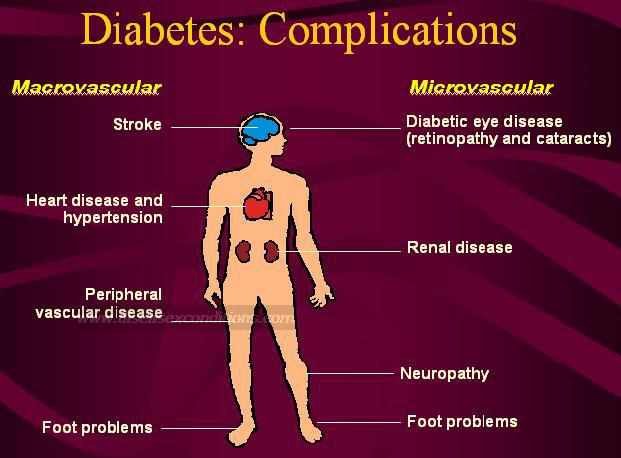
Fig: Complications of high blood/glucose level (source)
When the blood/glucose levels are high enough, it can cause damage to the tiny blood vessels which is known as microvasculature. In the arterioles, the walls develop some hyaline deposits and these deposits are made up of protein which makes it hard an inflexible, condition refering to as Hyaline Arteriosclerosis. Where as basement membrane are so thickened that the oxygen feels difficulty in moving to the cells from the capillaries leading to hypoxia. Diabetes mellitus has some significant effects on the severe medium and large arterial wall damage and atherosclerosis which can lead to Heart attacks and heart strokes (major cause of morbidity for the patients with Diabetes mellitus). Even in the eyes, the diabetes can lead to Diabetic Retinopathy which can be seen on fundoscopic examination. Cotton wool spots or flare hamorrhages are seen which can lead to blindness. Nephrotic syndrome rises as the efferent and afferent arterioles and glomerulus gets damaged which slowly causes an impact leading to slow filtering of blood overtime. Damaging the nerve pathways causes decrease in sensations in toes and feets known as stocking-glove syndrome , malfunctions of the autonomic nervous system which control the overall body functions. Due to the nerve damage and poor supply of the blood, ulcer rises in the feets which doesn't heal quickly becomes severe and needs to be amputated.
It's very important to diagnose, control and prevent the Diabetes through various medication, going on healthy lifestyles and some beta-cell therapy.
A team of scientists have created some of the synthetic pancreatic Beta-cells that has property of automatically release if the insulin when it senses high blood/glucose levels. In the future days, it will be available as non-invasive skin patch treatment for the Diabetes.
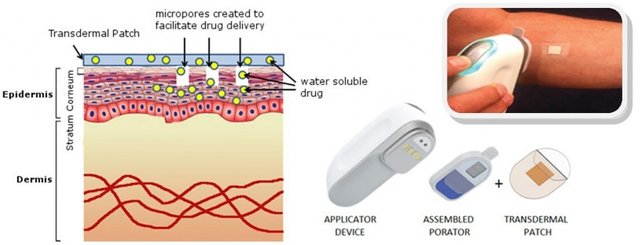
Fig: Transdermal patch for Insulin in Diabetic patient (source)
Experiment which shows that one injection of the synthetic Beta-cells kept the blood/glucose in normal levels in Diabetic mice for about 5 days of injection. From the past, there have been several attempts in developing a pill for insulin treatment but has been failed several times . Due to the strong digestive system that breaks down the large molecules of insulin pill , the product of this pill doesn't make to the bloodstream.
It is possible to treat the case of Diabetes from the transplantation of pancreatic cells but these treatments are too costly. These drugs need to suppress the immune reactions that does to the transplantation and have to be dependent on this cell. There is also high risk that this cell die off after transplantation. This product is a nanoparticles product that in cloaked in a cell membrane and microgels that slowly releases the drug.
The Beta-cells happens to be single compartment structure and also it is relatively passive .Due to this nature, it is difficult to interact with the biology of body. But the scientists have created a multi-compartment structure that mimics like a beta-cells that delivers the mixture of drugs or insulin that produces some effects. This is why the Beta-cells have to be smarter enough. Many such cells have been confirmed that mimics the high order functions of the natural beta cells which can detect the external environment , make some internal decision and produce some feedback is rare. But not, a new study by Professor. Gu made a cell that mimics just like the natural Beta-cell of pancreas. The synthetic Beta cell has a simple double membrane structure made up of lipids inside which are some vesicles or small sacs full of insulin structures. The professors also mentioned that it is the first time that we made a structure that can sense the blood/glucose level and trigger accordingly to it.
Now, some painless treatment that can deliver some synthetic beta cells using a skin patch in progress. Till now, a smart insulin patch is made which can sense the blood/glucose level and deliver insulin to the blood is possible. So, the goal is to further optimize and keep testing the synthetic cells in larger animals by developing some skin patch delivery system which can ultimately be tested in people with diabetes.
So this all for today's health blog. Hope to see you on another blog.
Thanks for a good read.
With Love,
khatisam4

Source:
(1)https://www.webmd.com/diabetes/guide/types-of-diabetes-mellitus#1
(2)https://www.medicinenet.com/diabetes_mellitus/article.htm
(4)http://www.who.int/mediacentre/factsheets/fs138/en/
(5)https://www.sciencedaily.com/releases/2016/03/160314140741.htm
(6)http://shareforthegreatergood.blogspot.com/2012/12/diabetes-complications.html
Last Health Post:
Age-Related Nuclear Cataract can be reduced by Healthy Diets !
Discovery of MUC5B gene in hearing loss of Otitis MEdia with Effusion Patient
Hey my friend it's a great to see your post about the diabetes and how insulin works and the various aspects of it thanks for such a nice post everyone should appreciate it.
Thanks funatoz ! Thanks for going through this !
So I can see you really put great effort to collect all the information than you deserve it
This is one of the most important post thanks for sharing !!!
Thanks @blazing for your reply and going through this post :)